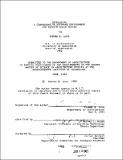| dc.contributor.advisor | Harvey J. Bryan. | en_US |
| dc.contributor.author | Lotz, Steven E | en_US |
| dc.contributor.other | Massachusetts Institute of Technology. Dept. of Architecture. | en_US |
| dc.date.accessioned | 2013-01-07T21:08:53Z | |
| dc.date.available | 2013-01-07T21:08:53Z | |
| dc.date.copyright | 1985 | en_US |
| dc.date.issued | 1985 | en_US |
| dc.identifier.uri | http://hdl.handle.net/1721.1/75957 | |
| dc.description | Thesis (M.S.)--Massachusetts Institute of Technology, Dept. of Architecture, 1985. | en_US |
| dc.description | MICROFICHE COPY AVAILABLE IN ARCHIVES AND ROTCH. | en_US |
| dc.description | Includes bibliographical references. | en_US |
| dc.description.abstract | This thesis is a journal which describes the thoughts and decisions leading up to the final design of a comprehensive software environment for passive solar design. The main purpose of this writing is to convey why a comprehensive software environment for this particular field is needed in order to help teach the principles of passive solar design, so that they can be adequately taken into consideration in the architectural design process, and how such a system could be implemented. A case study involving the use of previously available passive solar design tools is used to point out areas where these tools are deficient in their ability to focus a designer's attention on pertinent building performance simulation data, which could be more effectively used to influence design decisions at the various stages of the design process. This leads to a discussion of how these shortcomings could be overcome through a new and different software design strategy which utilizes a systems approach to build a more flexible and powerful passive solar design tool. Through further experiments, practical considerations and real-world constraints are brought to light, and how they affected the conceptual development of such a system which I undertook to develop here at MIT for Project Athena. Next, certain implementation details are given which seek to bridge the gap between conceptual goals and practical software design considerations. How the internal organization of software code affects the external interactions between the user and the system, and how it can promote the qualities needed for software survival in an educational setting is addressed . Finally, the outcome of an experimental prototype for this s y stem is discussed, as well as my concluding thoughts regarding what I have learned through this endeavor about writing architectural design tool software. | en_US |
| dc.description.statementofresponsibility | by Steven E. Lotz. | en_US |
| dc.format.extent | iv, 160, xix leaves | en_US |
| dc.language.iso | eng | en_US |
| dc.publisher | Massachusetts Institute of Technology | en_US |
| dc.rights | M.I.T. theses are protected by
copyright. They may be viewed from this source for any purpose, but
reproduction or distribution in any format is prohibited without written
permission. See provided URL for inquiries about permission. | en_US |
| dc.rights.uri | http://dspace.mit.edu/handle/1721.1/7582 | en_US |
| dc.subject | Architecture. | en_US |
| dc.title | Developing a comprehensive software environment for passive solar design | en_US |
| dc.title.alternative | Passive solar design, A comprehensive software environment | en_US |
| dc.type | Thesis | en_US |
| dc.description.degree | M.S. | en_US |
| dc.contributor.department | Massachusetts Institute of Technology. Department of Architecture | |
| dc.identifier.oclc | 13172710 | en_US |
